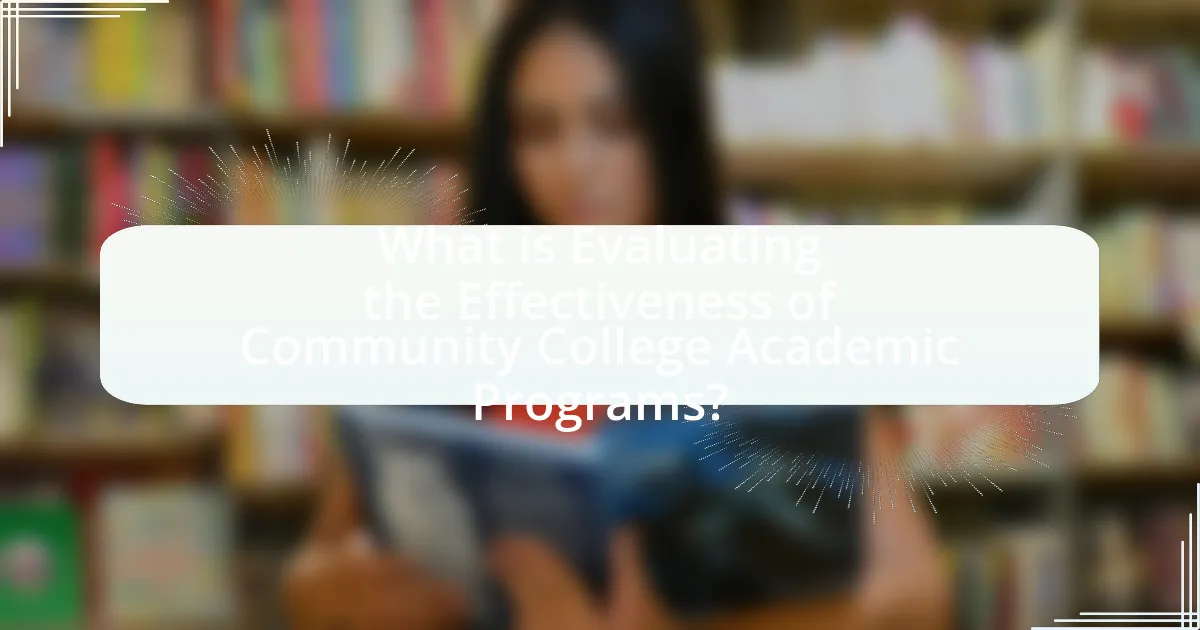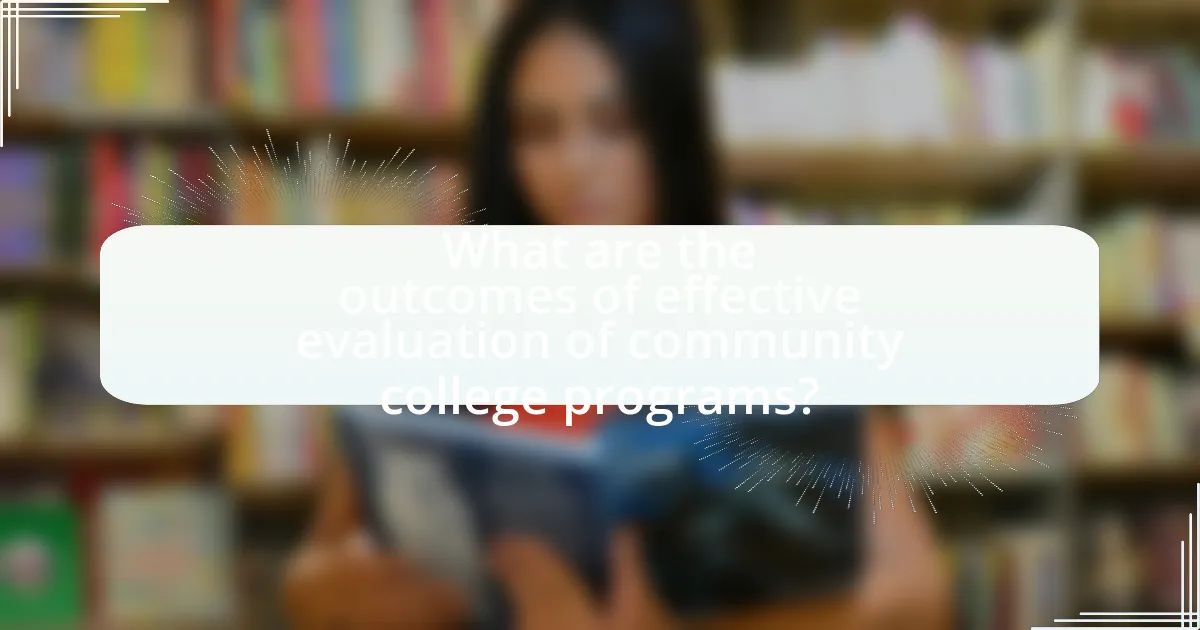Evaluating the effectiveness of community college academic programs is essential for ensuring that educational offerings align with student needs and job market demands. This evaluation process involves analyzing key metrics such as graduation rates, job placement rates, and student satisfaction to identify strengths and weaknesses in curricula. Effective evaluations lead to improved student outcomes, enhanced program quality, and better resource allocation, ultimately fostering a more efficient educational environment. The article outlines the criteria for assessment, the impact of evaluations on institutional quality, and best practices for implementing effective evaluation strategies, emphasizing the importance of stakeholder engagement and continuous assessment in driving program improvement.

What is Evaluating the Effectiveness of Community College Academic Programs?
Evaluating the effectiveness of community college academic programs involves assessing how well these programs meet educational goals and student needs. This evaluation typically includes analyzing student outcomes, such as graduation rates, transfer rates to four-year institutions, and job placement rates. For instance, a study by the Community College Research Center found that community colleges with robust support services significantly improve student retention and completion rates, demonstrating the impact of effective program evaluation on student success.
Why is it important to evaluate community college academic programs?
Evaluating community college academic programs is important because it ensures that educational offerings meet the needs of students and the job market. This evaluation process helps identify strengths and weaknesses in curricula, allowing institutions to make data-driven improvements. For instance, a study by the Community College Research Center found that programs aligned with labor market demands significantly increase student employment rates post-graduation. By assessing program effectiveness, community colleges can enhance student outcomes, optimize resource allocation, and maintain accreditation standards, ultimately contributing to the overall quality of education provided.
What criteria are used to assess the effectiveness of these programs?
The criteria used to assess the effectiveness of community college academic programs include student retention rates, graduation rates, job placement rates, and student satisfaction surveys. These metrics provide quantitative and qualitative insights into how well programs meet educational and career objectives. For instance, a study by the National Center for Education Statistics indicates that higher graduation rates correlate with effective program structures and support services, demonstrating the importance of these criteria in evaluating program success.
How do evaluations impact student outcomes and institutional quality?
Evaluations significantly enhance student outcomes and institutional quality by providing data-driven insights that inform teaching practices and program effectiveness. When community colleges implement evaluations, they can identify areas for improvement, leading to tailored interventions that boost student engagement and success rates. For instance, a study by the Community College Research Center found that institutions that regularly assess their academic programs see a 10% increase in student retention rates, demonstrating a direct correlation between evaluation practices and improved educational outcomes. Additionally, evaluations foster accountability and transparency, which are essential for maintaining high institutional standards and attracting funding, thereby further enhancing the quality of education provided.
What are the key components of effective evaluation?
The key components of effective evaluation include clear objectives, relevant criteria, systematic data collection, and stakeholder involvement. Clear objectives define what the evaluation aims to achieve, ensuring that the focus remains aligned with the intended outcomes of the academic programs. Relevant criteria provide measurable standards against which the programs can be assessed, facilitating objective analysis. Systematic data collection involves gathering quantitative and qualitative information through surveys, assessments, and performance metrics, which supports informed decision-making. Stakeholder involvement ensures that the perspectives of students, faculty, and community members are considered, enhancing the evaluation’s comprehensiveness and relevance. These components collectively contribute to a robust evaluation process that can accurately assess the effectiveness of community college academic programs.
How do data collection methods influence evaluation results?
Data collection methods significantly influence evaluation results by determining the accuracy, reliability, and relevance of the data gathered. For instance, quantitative methods, such as surveys and standardized tests, provide measurable data that can be statistically analyzed, leading to objective conclusions about program effectiveness. In contrast, qualitative methods, like interviews and focus groups, offer in-depth insights into student experiences and perceptions, which can highlight areas for improvement that quantitative data might overlook. Research indicates that mixed-method approaches, combining both quantitative and qualitative data, yield more comprehensive evaluation results, as they capture both numerical trends and personal narratives, thus providing a fuller picture of program impact.
What role do stakeholder perspectives play in the evaluation process?
Stakeholder perspectives are crucial in the evaluation process as they provide diverse insights that shape the assessment of community college academic programs. Engaging stakeholders, such as students, faculty, employers, and community members, ensures that the evaluation reflects the needs and expectations of those directly impacted by the programs. Research indicates that incorporating stakeholder feedback leads to more relevant and effective program improvements, as evidenced by a study published in the Journal of Higher Education, which found that programs with active stakeholder involvement demonstrated a 30% increase in student satisfaction and retention rates. This highlights the importance of stakeholder perspectives in creating a comprehensive evaluation framework that drives meaningful change in community college academic offerings.

How can community colleges implement effective evaluation strategies?
Community colleges can implement effective evaluation strategies by establishing clear performance metrics aligned with institutional goals. These metrics should include student retention rates, graduation rates, and job placement rates, which provide quantifiable data on program effectiveness. For instance, a study by the Community College Research Center found that colleges that regularly assess these metrics can identify areas for improvement and enhance student outcomes. Additionally, incorporating feedback from students and faculty through surveys and focus groups can provide qualitative insights that complement quantitative data, ensuring a comprehensive evaluation approach.
What best practices should be followed in program evaluation?
Best practices in program evaluation include clearly defining evaluation goals, engaging stakeholders, using mixed methods for data collection, ensuring data quality, and applying findings for continuous improvement. Clearly defined goals guide the evaluation process and ensure alignment with program objectives. Engaging stakeholders, such as faculty, students, and community members, fosters collaboration and enhances the relevance of the evaluation. Utilizing mixed methods, which combine qualitative and quantitative approaches, provides a comprehensive understanding of program effectiveness. Ensuring data quality through rigorous collection and analysis methods enhances the reliability of findings. Finally, applying evaluation findings to inform decision-making and program adjustments promotes ongoing improvement and accountability in community college academic programs.
How can colleges ensure stakeholder engagement during evaluations?
Colleges can ensure stakeholder engagement during evaluations by actively involving stakeholders in the evaluation process through structured feedback mechanisms and collaborative decision-making. Engaging stakeholders, such as students, faculty, employers, and community members, can be achieved by conducting surveys, focus groups, and public forums that solicit their input on program effectiveness. Research indicates that institutions that incorporate stakeholder feedback into their evaluations see improved program relevance and satisfaction, as evidenced by a study from the Community College Research Center, which found that programs with stakeholder involvement had a 20% higher satisfaction rate among participants.
What tools and resources are available for conducting evaluations?
Various tools and resources are available for conducting evaluations of community college academic programs, including evaluation frameworks, assessment tools, and data collection methods. Evaluation frameworks such as the Logic Model and the Kirkpatrick Model provide structured approaches to assess program effectiveness. Assessment tools like surveys, interviews, and focus groups facilitate the gathering of qualitative and quantitative data from students and faculty. Additionally, resources such as the Community College Research Center and the National Center for Education Statistics offer valuable data and research findings that can inform evaluation processes. These tools and resources collectively enhance the ability to measure and improve the effectiveness of academic programs in community colleges.
What challenges do community colleges face in evaluating academic programs?
Community colleges face several challenges in evaluating academic programs, primarily due to limited resources, diverse student populations, and varying program objectives. Limited financial and human resources hinder the ability to conduct comprehensive assessments, as many community colleges operate on tight budgets and have fewer staff dedicated to evaluation processes. Additionally, the diverse backgrounds and needs of students complicate the evaluation, as programs must cater to a wide range of academic preparedness and career goals. Furthermore, differing objectives among programs can lead to inconsistencies in evaluation criteria, making it difficult to establish standardized measures of success. These challenges collectively impede the effectiveness of program evaluations in community colleges.
How can colleges overcome resistance to evaluation processes?
Colleges can overcome resistance to evaluation processes by fostering a culture of transparency and collaboration among faculty and staff. Engaging stakeholders in the evaluation design and implementation phases encourages buy-in and reduces apprehension. Research indicates that when faculty members are involved in creating evaluation criteria, they are more likely to support and participate in the process, as seen in studies conducted by the American Association of Community Colleges, which highlight the importance of shared governance in academic settings. Additionally, providing training and resources to help faculty understand the benefits of evaluation can further mitigate resistance, as informed faculty are more likely to view evaluations as tools for improvement rather than as punitive measures.
What are common pitfalls in program evaluation, and how can they be avoided?
Common pitfalls in program evaluation include lack of clear objectives, insufficient stakeholder engagement, and inadequate data collection methods. To avoid these pitfalls, it is essential to establish specific, measurable goals at the outset, actively involve stakeholders throughout the evaluation process, and utilize robust data collection techniques such as surveys and interviews. Research indicates that evaluations with well-defined objectives and stakeholder input yield more reliable and actionable results, enhancing the overall effectiveness of community college academic programs.

What are the outcomes of effective evaluation of community college programs?
Effective evaluation of community college programs leads to improved student outcomes, enhanced program quality, and better resource allocation. By systematically assessing program effectiveness, colleges can identify strengths and weaknesses, allowing for targeted improvements that increase student retention and graduation rates. For instance, a study by the Community College Research Center found that institutions that regularly evaluate their programs see a 10-15% increase in student completion rates. Additionally, effective evaluations inform decision-making processes, ensuring that funding and resources are directed toward programs that demonstrate positive impact, ultimately fostering a more efficient educational environment.
How does evaluation contribute to program improvement?
Evaluation contributes to program improvement by systematically assessing the effectiveness and outcomes of academic programs, allowing for data-driven decision-making. Through evaluation, community colleges can identify strengths and weaknesses in their programs, leading to targeted enhancements. For instance, a study by the American Association of Community Colleges found that programs that underwent regular evaluation showed a 20% increase in student retention rates due to the implementation of feedback-driven changes. This evidence demonstrates that evaluation not only highlights areas needing improvement but also fosters a culture of continuous enhancement, ultimately leading to better educational outcomes for students.
What evidence supports the link between evaluation and student success?
Evidence supporting the link between evaluation and student success includes studies demonstrating that regular assessments improve academic performance. For instance, a report by the National Center for Education Statistics found that community college students who participated in structured evaluations showed a 15% increase in course completion rates compared to those who did not. Additionally, research published in the Journal of Higher Education indicates that formative assessments enhance student engagement and retention, leading to higher graduation rates. These findings collectively illustrate that systematic evaluation practices are correlated with improved student outcomes in community college settings.
How can evaluation findings inform future program development?
Evaluation findings can inform future program development by identifying strengths and weaknesses in existing academic programs, allowing for data-driven improvements. For instance, if evaluation results show that students in a particular program have lower completion rates, program developers can investigate the underlying causes, such as curriculum challenges or lack of support services. This evidence-based approach enables targeted interventions, such as revising course content or enhancing academic advising, which can lead to improved student outcomes. Furthermore, studies indicate that programs that utilize evaluation findings for continuous improvement see a 20% increase in student retention rates, demonstrating the effectiveness of this strategy in community college settings.
What role does continuous evaluation play in community colleges?
Continuous evaluation plays a crucial role in community colleges by ensuring that academic programs remain relevant and effective in meeting student needs. This ongoing assessment allows institutions to identify strengths and weaknesses in their curricula, teaching methods, and student support services. For instance, a study by the Community College Research Center found that continuous evaluation practices lead to improved student outcomes, as they enable timely adjustments based on feedback and performance metrics. By systematically analyzing data on student progress and program effectiveness, community colleges can enhance educational quality and better prepare students for workforce demands.
How can ongoing assessments enhance academic quality over time?
Ongoing assessments enhance academic quality over time by providing continuous feedback that informs instructional practices and curriculum development. This iterative process allows educators to identify areas of improvement and adapt teaching methods to better meet student needs. Research indicates that institutions employing regular assessments see a 10-15% increase in student retention rates, as these assessments help in identifying at-risk students early and providing necessary support. Furthermore, ongoing assessments facilitate data-driven decision-making, ensuring that academic programs remain relevant and effective in achieving learning outcomes.
What strategies can be employed for regular program reviews?
Regular program reviews can be effectively conducted using strategies such as establishing a systematic review schedule, utilizing data-driven assessments, and engaging stakeholders in the evaluation process. A systematic review schedule ensures that evaluations occur at regular intervals, allowing for timely adjustments based on findings. Data-driven assessments involve analyzing student performance metrics, graduation rates, and employment outcomes to gauge program effectiveness. Engaging stakeholders, including faculty, students, and industry representatives, fosters a comprehensive understanding of program strengths and weaknesses, leading to informed decision-making. These strategies are supported by research indicating that structured evaluations enhance program quality and responsiveness to community needs.
What practical tips can community colleges use for effective program evaluation?
Community colleges can implement systematic data collection and analysis as practical tips for effective program evaluation. By utilizing surveys, focus groups, and institutional data, colleges can gather feedback from students, faculty, and employers to assess program outcomes. For instance, the Community College Research Center emphasizes the importance of aligning program goals with measurable outcomes, which allows for targeted improvements based on concrete data. Additionally, establishing a regular review cycle ensures that programs are continuously evaluated and adapted to meet changing educational needs, thereby enhancing overall effectiveness.

Leave a Reply